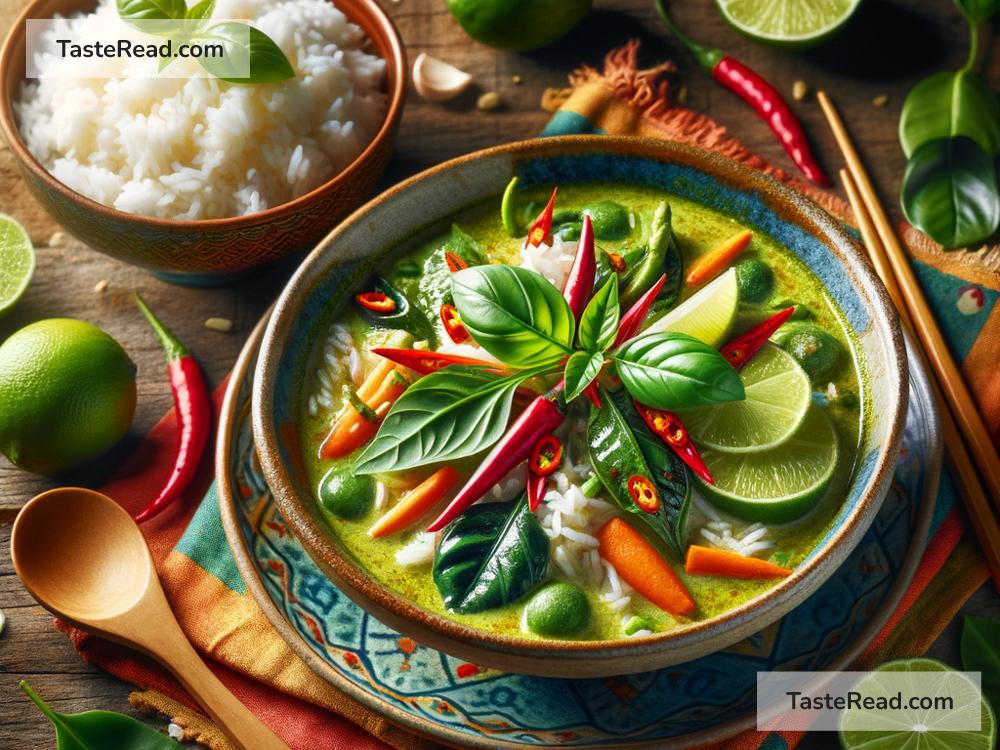The Ultimate Guide to Perfecting Thai Green Curry at Home
Thai green curry is one of the most popular dishes in Thai cuisine, loved for its rich, creamy texture and aromatic flavors. If you’ve ever ordered it at a restaurant and wished you could recreate it at home, you’re in luck! With this simple guide, you’ll learn how to make authentic Thai green curry that’s both delicious and customizable. Whether you’re new to cooking or just looking to improve your skills, this guide breaks everything down step by step.
What Makes Thai Green Curry Special?
Thai green curry gets its name from the vibrant green color of the curry paste, which is made with green chilies, herbs, and spices. It’s less spicy than Thai red curry but still packs a flavorful punch. The combination of fresh ingredients like coconut milk, lemongrass, galangal, and kaffir lime leaves creates a creamy and fragrant dish that’s perfect for anyone who loves Thai food.
Thai green curry is usually made with chicken, but it can also be made with shrimp, beef, or even tofu for a plant-based version. Vegetables like eggplant, bamboo shoots, and bell peppers are often added to give the curry texture and color. The beauty of this dish is that you can adapt it to suit your preferences and dietary needs.
The Essentials You’ll Need
Before you start cooking, gather the key ingredients to make Thai green curry. Here’s what you’ll need:
For the green curry paste:
– 5–6 green chilies (adjust based on your spice tolerance)
– 2 tablespoons chopped lemongrass
– 1 tablespoon galangal (or ginger if you can’t find galangal)
– 3 cloves garlic
– 2-3 shallots
– Zest of one kaffir lime (or lime as a substitute)
– 1 teaspoon ground coriander
– 1 teaspoon ground cumin
– A handful of fresh cilantro leaves
For the curry:
– 1 can (400ml) of coconut milk
– 2 cups of protein (chicken, shrimp, tofu, or beef)
– 2 cups of vegetables (eggplant, bamboo shoots, bell peppers, or zucchini)
– 2–3 kaffir lime leaves (optional but highly recommended)
– 1 tablespoon fish sauce
– 1 teaspoon sugar (or palm sugar for extra authenticity)
– 1-2 tablespoons vegetable oil
– Fresh Thai basil and red chilies for garnish
Step-by-Step Cooking Guide
1. Make the Green Curry Paste
Start by making the curry paste. This step is key to achieving the authentic flavors of Thai green curry. Blend all the paste ingredients (green chilies, lemongrass, galangal, garlic, shallots, kaffir lime zest, coriander, cumin, and cilantro) in a food processor or mortar and pestle until you get a smooth, bright green paste. Set it aside.
If you’re short on time or can’t find all the ingredients, you can buy pre-made green curry paste from an Asian grocery store. It won’t be quite the same as homemade, but it’s still a good option for beginners.
2. Prepare Your Protein and Vegetables
Cut your protein into bite-sized pieces and chop your vegetables. For chicken, use thigh fillets for extra tenderness. If using shrimp, remove the shells and tails for easier eating. For tofu, make sure you use firm tofu so it doesn’t crumble in the curry. You can also prepare extra veggies to boost the nutritional value of the dish.
3. Cook the Curry Paste
Heat 1–2 tablespoons of vegetable oil in a large pan or wok over medium heat. Add the green curry paste and stir for 1–2 minutes until fragrant. This step allows the spice mixture to release its flavors.
4. Add Coconut Milk
Pour in the coconut milk and stir it with the curry paste. You’ll notice the sauce turning creamy and rich. Let it simmer for 5 minutes to mix the flavors.
5. Add Protein and Vegetables
Add your protein to the pan and cook until it’s fully done. Chicken and beef usually take around 15 minutes, while shrimp only needs 5 minutes to cook. If using tofu, add it later since it’s already cooked. Next, toss in your vegetables and let them simmer for 5–10 minutes until tender.
6. Season the Curry
Stir in the fish sauce and sugar to balance the flavors. If you don’t eat fish sauce, you can substitute soy sauce for a similar salty taste. Adjust the seasoning based on your preference, adding more fish sauce for saltiness or sugar for sweetness.
7. Garnish and Serve
Turn off the heat and add kaffir lime leaves for extra aroma. Garnish the curry with fresh Thai basil leaves and sliced red chilies for a pop of color and spice. Serve over steamed jasmine rice or noodles for a satisfying meal.
Tips for Perfecting Your Thai Green Curry
- Use fresh ingredients: Fresh herbs and spices make all the difference in flavor. Try to find authentic Thai ingredients at an Asian grocery store.
- Adjust spice levels: Green curry can be mild or spicy depending on the amount of chilies you use. Start with fewer chilies if you’re unsure, and add more later if needed.
- Don’t rush: Let the flavors simmer and blend naturally. Rushing the cooking process might leave the curry tasting flat.
- Experiment: Customize the curry with your favorite proteins and vegetables. You can even make vegetarian or vegan versions by skipping the fish sauce and using vegetable broth instead.
Final Thoughts
Making Thai green curry at home doesn’t have to be intimidating. With this guide, you can cook a flavorful and authentic dish that rivals your favorite Thai restaurant. Once you’ve mastered the basics, feel free to experiment with ingredients to create your own signature curry. Invite friends and family over to enjoy your homemade creation, and don’t forget to share the recipe!
Happy cooking!


